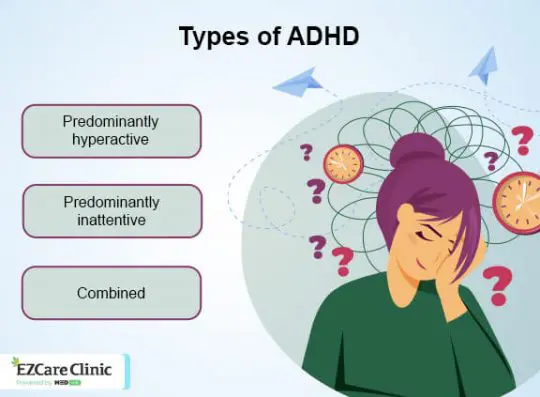Attention deficit hyperactivity disorder (ADHD) is a behavioral disorder that causes symptoms of hyperactivity, inattention, and impulsivity severe enough to interfere with the patient’s daily activities. While ADHD primarily develops in childhood, the symptoms can continue into adulthood.
Adults with ADHD often struggle with excessively impulsive behaviors, cannot pay attention, and are overly active. However, the symptoms of ADHD may vary from one person to another. The different types of ADHD affecting adults are categorized based on one’s behavior and symptoms.
ADHD can manifest itself differently. Consult a professional to go through a detailed assessment.
How Many Types of ADHD are There?
There are three main types of ADHD in adults: predominantly hyperactive, predominantly inattentive, and combined. Below, you will find a detailed explanation of these types of adult ADHD and accompanying symptoms.
Predominantly Hyperactive ADHD
This ADHD type is typically marked by hyperactive and impulsive behavior. Adults diagnosed with it don’t present symptoms of inattentiveness but can notice the following:
- Fidgeting, tapping hands or feet, or squirming in the seat.
- Talking excessively.
- Inability to settle in one place and remain still for an extended period without feeling discomfort. One can stand up or leave their seat at work or in other situations that require people to remain seated.
- Feeling restless in most situations.
- Inability to engage in leisure activities or hobbies quietly.
- Blurting out answers before the question is complete.
- Inability to wait for their turn, such as when queuing.
- Interrupting or intruding into conversations, activities, or games.
Predominantly Inattentive ADHD
Previously called ADD, ADHD of the inattentive type is characterized by distractibility and lack of attention. However, people with this ADHD type don’t have hyperactive behaviors. Common symptoms of inattentive ADHD include:
- Inability to pay close attention. Making careless mistakes at work.
- Daydreaming and difficulty sustaining attention. Inability to remain focused for extended periods.
- Inability to listen when being talked to, even without obvious distractions.
- Inability to follow instructions or complete assigned tasks.
- Inability to organize tasks and activities.

- Struggling to manage time and meet deadlines.
- Reluctance to engage in activities that require extensive mental concentration.
- Distractibility by external stimuli, including unrelated thoughts.
- Extreme forgetfulness.
Combined Type
As the name suggests, the combined ADHD type has the symptoms of both hyperactive-impulsive and inattentive behaviors. The doctor or physician will diagnose patients with combined ADHD if they present enough symptoms of each of the above-mentioned ADHD types.
How is ADHD Diagnosed?
Healthcare providers use the symptoms provided in the
Clinicians can diagnose ADHD in adults only if they present with at least five of the nine primary symptoms. The symptoms should also be visibly present for six months or more in more than two settings, such as at home and at work. Additionally, these symptoms should be severe enough to interfere with the adult’s daily activities.
Discuss any disturbing mental health symptoms with our licensed MDs.
Treatment of ADHD
Healthcare providers can suggest several treatment options for patients diagnosed with ADHD. Treatment for ADHD focuses on managing symptoms and promoting positive behaviors with the help of psychotherapy and medications.
Therapy
Doctors often recommend behavioral therapy for ADHD. Behavioral therapy helps adults with ADHD find ways of replacing inappropriate behaviors with positive ones. It also helps them learn new ways of expressing their feelings.
Therapeutic options, such as
Medication
Medications for ADHD help reduce hyperactivity and impulsivity and improve the patient’s ability to focus and physical coordination. The two common types of drugs used for the treatment of ADHD are:
- Stimulants. These are the most prescribed medicines for ADHD because of their stimulation benefits. Regardless of the stimulant drug used, it increases the production of norepinephrine and dopamine in the brain, the key neurotransmitters that regulate the thought process and attention. Examples of stimulant medications for ADHD include Adderall, Focalin, and Ritalin.
- Nonstimulants. These drugs take longer to act but are effective in improving the patients’ attention and focus. They are recommended for patients who can’t tolerate stimulants or do not gain the desired effect from them. Examples of non-stimulant drugs for ADHD include Strattera, Qelbree, and Intuniv.

Patients should see their healthcare providers to find the best treatment option. Physicians can combine these treatments to help ADHD patients with severe symptoms.
Conclusion
ADHD is a lifelong behavioral disorder that affects many people. Adults with ADHD may struggle at home and work because of various intrusive symptoms. However, there are several options that can help make your life less challenging. While there’s no cure for adult ADHD, medications and psychotherapy can help manage the symptoms effectively. Contact EZCare doctors to go through an assessment and get a personalized treatment plan.
Sources
- DSM-5 Changes: Implications for Child Serious Emotional Disturbance. (2016)
Source link - Description and Demonstration of CBT for ADHD in Adults. (2012)
Source link







